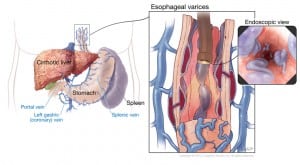 Esophageal varices are enlarged veins within the esophagus (tube connecting throat to the stomach), are most often due to problems with blood flow in the liver.
Esophageal varices are enlarged veins within the esophagus (tube connecting throat to the stomach), are most often due to problems with blood flow in the liver.
Normally, a blood vessel called the portal vein carries blood from the digestive organs to the liver. But with liver disease, blood flow can become blocked due to scarring of the liver. This increases the blood pressure in the portal vein (a condition known as portal hypertension). Blood then backs up in nearby veins in the esophagus and stomach, causing varices.
Varices are a serious and life-‐threatening problem. Blood vessels in the esophagus become abnormally enlarged. Treatment is needed to prevent them from rupturing and bleeding. If bleeding occurs, it can be fatal.
Symptoms of Esophageal Varices
Symptoms do not occur unless the varices are bleeding. This is an emergency problem.
If you have any of the following symptoms, get immediate medical attention:
- Vomiting blood
- Black, tarry, or bloody stools
- Lightheadedness or loss of consciousness (fainting)
Diagnosing Esophageal Varices
You’ll likely be checked for varices if you have liver disease or other associated health problems.
Tests to confirm varices include:
- Upper endoscopy to see inside the upper digestive tract and check for the presence of varices and any bleeding.
- Ultrasound and CT imaging provide pictures of the liver or blood flow in the liver. They allow the doctor to check for enlarged veins around the liver and assess the risk of bleeding.
Treating Esophageal Varices
The goal of treatment is to reduce the risk of bleeding or to control bleeding.
Treatment can include one or more of the following:
- Medication prescribed to lower blood pressure inside the enlarged veins. This reduces the risk of bleeding. Beta-‐blockers are the most common medication used.
- Endoscopic therapy is performed for enlarged or bleeding veins. With ligation, small rubber bands are placed around the veins to close them off and stop any bleeding. With sclerotherapy, clotting medication is injected into the veins to shrink them.
- Balloon tamponade is a procedure in which a tube with a balloon is guided down into the esophagus and stomach. The balloon is then inflated with air to apply pressure on enlarged or bleeding veins to control bleeding.
- Surgery may be performed to place a stent in the liver to help reroute blood flow in the liver to lower the blood pressure in enlarged veins. Sometimes, the enlarged veins may be connected to other nearby veins to reroute blood flow. In severe cases, a liver transplant may be needed to replace the diseased liver with a healthy donor liver.
- Follow-‐Up visits with the doctor are needed to check for bleeding of the varices. If bleeding occurs, it is likely to occur again. More treatments will then be needed in the future. Work closely with your doctor to manage your condition and know when to seek emergency care.

